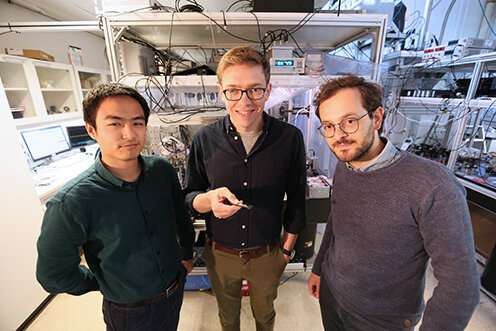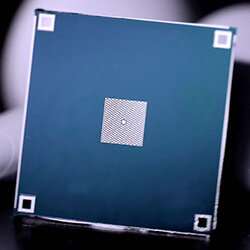Researchers break quantum limit in the precision of force and position measurements

Researchers of the Schliesser Lab at the Niels Bohr Institute, University of Copenhagen, have pushed the precision of force and position measurements into a new regime. Their experiment is the first to surpass the so-called "Standard Quantum Limit," or SQL, which arises in the most common (and successful) optical techniques for ultra-precise position measurements. For more than 50 years, experimentalists have raced to beat the SQL using a variety of techniques, but to no avail. In their recent work, the researchers at the Niels Bohr Institute have done the trick with a simple modification of the standard approach, which enables the necessary cancellation of quantum noise in the measurement. The result and underlying experiment have potential implications for gravitational wave astronomy techniques, as well as force microscopy with biological applications. The work is now published in the prestigious scientific magazine, Nature Physics.
The trouble with quantum noise
Quantum actions have quantum consequences. In the context of measurements, this often means that the very act of measuring a quantum system disturbs it. This effect is referred to as 'backaction," and is a consequence of fundamental quantum uncertainties, first conceived by Werner Heisenberg during his stay at Niels Bohr's Copenhagen Institute in the 1920s. In many instances, this sets a limit to how precise a measurement can get.
Gravitational wave telescopes like LIGO, the Laser Interferometer Gravitational-Wave Observatory, whose discoveries were awarded the 2017 Physics Nobel prize, bounce laser light off a mirror to measure its position, in an optical configuration known as an interferometer. The "imprecision" of this measurement can be improved by increasing the laser power, but eventually the random kicks of the laser photons will disturb the mirror position, leading to a less-sensitive measurement which leaves faint or distant astronomical objects undetected. By optimally balancing the imprecision noise and backaction, one can reach a minimum amount of extra noise, establishing the "Standard Quantum Limit' (SQL). This minimum noise level sets the best precision possible by any conventional interferometer.

To get around this limit, one must modify the interferometer in some way to avoid these quantum noise sources. In the 50 years since the SQL was established, various proposals have been put forth, and recent years have brought several proof-of-principle experimental demonstrations. So far, no experiment has actually measured the position of an object with a precision which beats the SQL. But this is precisely what the Copenhagen team has accomplished, thanks to advanced optical and nanomechanical techniques.
Better than the gold standard
"The SQL is something of a gold standard for the quality of a measurement. It is nothing that can't fundamentally be overcome, but as far as force and position measurements are concerned, it turned out to be very hard. Even LIGO isn't there yet. But with our system we thought we should stand a chance," explains Prof. Schliesser, who led the team. This system is an experimental platform developed in Schliesser's group over the last years. Just like LIGO, it uses a laser-powered interferometer to measure a position, in this case that of a membrane made of the ceramic silicon nitride. While very thin (20 nanometers), the membrane is several millimeters wide and easily visible by the naked eye. The 'trick' employed by the researchers to go beyond the SQL involves making a special measurement of the light reflected off the membrane. In this configuration, the detector is able to simultaneously measure both the imprecision and backaction in a way that lets these noise sources cancel each other out. In other words, what remains is a "clean" measurement.
30 percent improvement is very good news for practical applications
"Once we knew we could get very close to the SQL, the modifications required to beat it were actually rather straightforward," explains Dr. David Mason, a US postdoc in Copenhagen, and lead author of the study. "We are using quantum effects that arise in the measurement setup itself, so the extra technological effort is actually limited. That is good news for potential practical applications." Using this technique, the group at NBI was able to measure the position of their membrane with a precision nearly 30 percent better than what the SQL would allow. This marks a watershed moment for quantum measurements of mechanical objects, highlighting how far the state-of-the-art has been advanced, and suggesting a bright path ahead. Opto-mechanical systems like the one studied here are poised to continue aiding the development of techniques related to gravitational wave astronomy, while also applying their extreme sensitivity in other arenas. Devices from the Schliesser Lab are already being integrated into state-of-the-art force-sensing applications, where they may enable MRI-like images at a nanometer scale, perhaps imaging individual HI or influenza viruses.
More information: David Mason et al. Continuous force and displacement measurement below the standard quantum limit, Nature Physics (2019). DOI: 10.1038/s41567-019-0533-5
Journal information: Nature Physics
Provided by Niels Bohr Institute




















